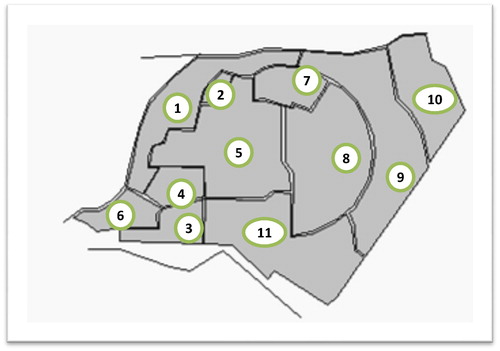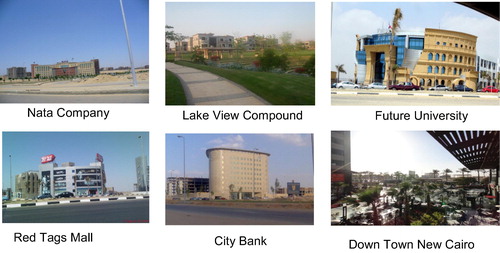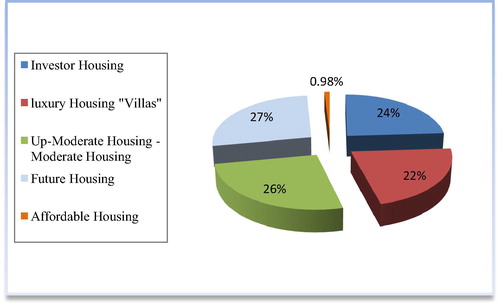Abstract
Urban development differs from one country to another. The various aims and ways differ according to the different economical, social and environmental situations. Many countries followed the policy of establishing new cities in the aim of redistribution of the population or to be as a nucleus that assists in encouraging the economic activity of a certain region or to be a new capital.
Egypt has adopted the policy of establishing the new cities for national aims. Many cities were being developed according to development stages, from the first generation, the second generation to the third generation. New Cairo is one of the second generation cities. It is characterized by its distinctive developed location. It has been developed as a result of the economy and investment politics of the Egyptian government at this time, which made it the focus of real estate investment. However, this resulted in negative influences on the sustainability.
That is made clear in the different stages of developing the city, – before laying the general comprehensive plan, during preparing the plan and the successive stages of development till now.
This research reviews the basis of development of the new cities. The influence of the real estate investment in some Arab countries, then it handles the case study – “New Cairo city”. Discussing all the investing factors made the city in its current status. Then comes the recommendations in a trial to get an alternative structure to achieve sustainability in light of the current determinants and growth stages.
New cities and objectives of development
New cities: These are the formula that the countries are adopted to solve the urban crisis. It is defined as combining all areas to create better urban centers that achieve social prosperity as well as economic development, in the aim of re-distributing cities through preparing new attraction zones outside the old cities and villages [Citation1].
Fig. 2 New Cairo city general plan [Citation13].
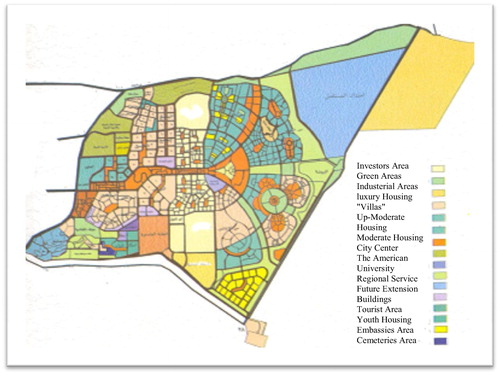
Fig. 4 New Cairo city center [Citation13].
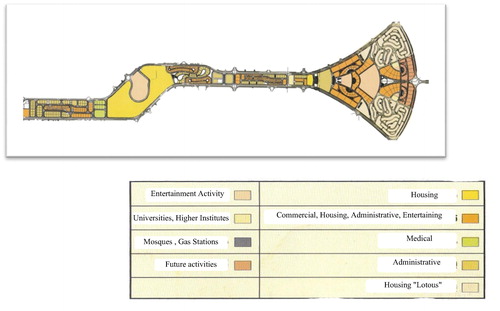
Fig. 6 Industrial zone in New Cairo city [Citation13].
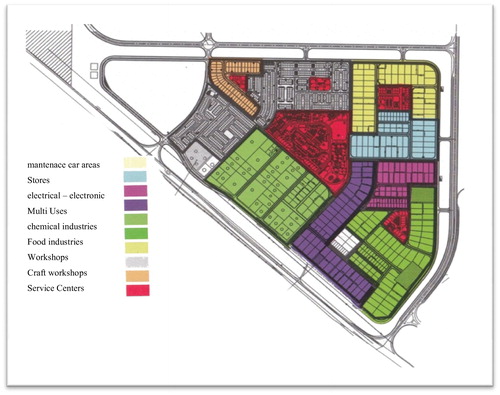
It is natural that cities structure differs according to the different situations in the economy, society and environment. So new cities may be built with the aim of re-distributing urban development to re-locate the crowded zones or to foster economy and activate certain zones to be a new capital, or it can re-distribute the urban center, or to be built for the workers as it was built during the industrial revolution. In Egypt, the main aim of this formula is to be a trial to solve the urban crisis of over-population and the crowded capitals. There are, however, no services that accompany this connection of over population. The objectives of Establishing the New Cities are three main groups which are [Citation2]:
First: Social objectives
| • | Providing the different types of housing for all the needs of the different citizens, including the number of families size and social habits. | ||||
| • | Providing social services that cater to all the requirements of the citizens, according to the quality and quantity. | ||||
| • | Providing suitable employment opportunities in which the factors of economic and social insurance are achieved in accordance with the social nature of these cities and their needs. | ||||
Second: Economic objectives
| • | Creating new economical bases that seek to achieve a certain kind of balance on the regional and national levels, and increase the self-sufficiency of the city and improving the level of social activities. | ||||
| • | Economic development offers investment opportunities and economic factors potentials. | ||||
| • | Encouraging investment and attracting foreign capital. | ||||
Third: Urban objectives
| • | Reshaping the Urbanism on the national level in accordance with the national development strategy. | ||||
| • | The balanced distribution of population on all the national maps. | ||||
| • | The strategic distribution of the higher security aims and national domain of the whole government. | ||||
In terms of establishing; the new cities are divided into two types [Citation3]:
| (1) | Independent Cities: These have development status and do not depend on an existing community, but pass the traits of sustainability aiming at reaching certain different aims in addition to sustainable housing. They are located far from the cities with suitable distance that provide independence with the aim of establishing, on the long term-economical centers that are independent which lead them to gather the different economic and social activities. | ||||
| (2) | The New Satellite Cities: The existing population is based on a community that has been there for a while – if they are working outside the city, they become night housing only. Services and employment in attracting citizens and activities and seek to lessen the population and benefits to the existing population activities to create new-work opportunities and economical components that are linked to the capital city. | ||||
Real estate investment and its effect on changing the policy of establishing new cities
| • | Investment is defined in its economic theories as a part of a whole of the accumulated investment during the years that was used in activities with the aim of increasing and achieving growth to preserve the force of saving money [Citation4]. | ||||
| • | The Real Estate Investment is defined as being one of the trade activities that had to do with the investment money in the field of establishment and housing and assist in the prosperity and the movement of the economy in general [Citation5]. | ||||
| • | The real estate investment is an expression that is comprehensive as it includes three kinds of essential real estate investment that are all included under the title of real estate which are [Citation6]:
| ||||||||||||||||||||||
| • | The new cities development in the economies of the Arab countries has adopted in the last period on the investment giant gatherings, which have been created in the new kinds of cities as a partner supported by different governments; the investment arm affected the city and depended on certain commercial aim; the research handles some of the following: | ||||||||||||||||||||||
Economic cities in Saudi Arabia
Economic Cities create value and opportunities for citizens, businesses, and society by efficiently utilizing all tangible and intangible assets, and enabling productive, inclusive, and sustainable economic activity [Citation7].
Saudi Arabia General Investment Authority is responsible for supervising the implementation of the basic equipment and infrastructure works, and the establishment of service centers, and regulates the entry of investors and determines their positions according to economic activity and help to license them from the concerned authorities in accordance with the rules and regulations. The cities are: King Abdullah Economic City (KAEC), Medina Knowledge Economic City (MKEC), Prince Abdulaziz Bin Mousaed Economic City (PABMEC), and Jazan Economic City.
To ensure success, the economic cities developed under Saudi Arabia General Investment Authority, according to six key design principles as follows [Citation8]:
| (1) | Each city will be developed around at least one globally competitive cluster or industry, which will serve as an anchor and a growth engine for the city, around which other businesses will locate. | ||||
| (2) | The cities will utilize their Greenfield opportunity to adopt state-of-the-art technology solutions to make them truly competitive. | ||||
| (3) | Each city will be developed by the private sector, and will therefore generate major private investment opportunities in infrastructure, real estate and industry. | ||||
| (4) | By Identifying and attracting core investors; jobs will be created which will spur other supporting service jobs. | ||||
| (5) | To achieve the highest aspirations in terms of job creation and investment volume, the cities need to offer an attractive lifestyle to grow beyond a mere industrial free zone. | ||||
| (6) | The cities will enjoy a business friendly regulatory environment which is competitive to other free zones globally. | ||||
Sustainable city in United Arab Emirates “Masdar City” [Citation9]
Masdar City is being constructed 17 km east-south-east of the city of Abu Dhabi, beside Abu Dhabi International Airport.
The city is acting as a certain economic area while concentrating on the clear technicians and renewable energy to be a part of a lot of crowded industrial projects working in the field of eco-friendly fields as well and providing a chance for the companies to stem from the possibility of testing clear methods presenting the development and marketing them. The city also provides lots of advantages to establish clear projects, including a Unified window that facilitates the licensing and recruitment procedures as giving foreigners the right to full ownership of their projects and the freedom of capital and profits fully convertible and exemption from import and export taxes and personal income taxes and corporate taxes.
The Masdar city area was divided into: 30% for residential areas, 24% for business and research, 13% for commercial projects, including light industry, 6% for “Masdar Institute of Science and Technology”, 19% for services and transportation, and 8% of civil and cultural events [Citation10].
Smart cities [Citation11]
Many governments in the Arab countries are trying to launch the thought of smart cities to support economic plans and provide informational and technological climate to support the real estate investment. Belief in the value of technology is to increase the economic and administrative efficiency, improve the social standards of justice and security, increase economic growth and raise the efficiency of the transmission investment funds across borders.
Studying the impact of real estate investment on New Cairo city
New Cairo city lies in the eastern area of Cairo on the ring road and located in the area between Cairo-Suez desert road and Cairo El Ain El Sokhna desert road. It is considered one of the second generation cities which include Badr, New Bani Sweif, New Menia, Nubariya, ElSheik Zayed, El Obour, El Shourouk which is one of the biggest cities there. Its area reached 70 thousand feddan.
Stages of developing New Cairo city
The establishment of New Cairo city passed through four stages; The beginning was three settlements among the ten that were suggested around Greater Cairo region (El-Tagamoa “first, third and fifth”. The settlements suggested to urbanize the location of the city, with the success of the economic housing there. Requests from investors increased on such distinctive land as to their location near to the ring road and the districts of Nasr City and Heliopolis.
The decree was issued in 1995 to establish the city that was composed of the existing three settlements and the areas between them in addition to the eastern extensions. In 1997 another decree was issued by adjusting the extensions of the city once more. It was established with a Presidential decree number (1 9 1) for the year 2000 the eastern parts were annexed to the cordon of the city, leasing it to some private and public companies.
The decree was successive by adding some other areas to the cordon of the city without a final settling on the total area of the city.
New Cairo city as a hub of real estate investment
The attraction of investment in lands has to do with it being a secure investment and it achieves a high profit. The urban settlements allowed huge areas of lands to be available which attracted investments (Egyptian – Foreign – Arab Gulf) to buy thousands of feddan and establish housing projects. The housing process was transferred in the new settlements from housing to an investment that influences the personal savings. This progress accompanied The Real Estate investment with the progress of New Cairo that lies in the area located between Cairo-Suez desert road and Cairo-Ain El Sokhna road east of the ring road circling the capital, that include more than one vital exit that is near to the entrances as well as linking New Cairo with all the other vital areas in eastern Cairo. Also the New Cairo is far away from Nasr City by 10 km and the New Cairo is away from Maadi by 15 km and near Cairo international airport.
Its general location and the economic period and political one that was established to attract investment as: (1) There is a certain ease to reach the location; (2) The location is distinctive and it is near the permanent housing; (3) Services and leisure areas are present; (4) Facilities and other networks, sewage and electricity are provided; (5) Good planning and design.
The city acquired great fame among the new urban settlements. New Cairo was able to appear clearly among the new cities in the outskirts of the capital. The new urban communities authority website (2006) pointed out the greatest investments in the new cities were awarded to the New Cairo city.
General plan
(A) Development stages
| • | The general plan was affected by the previous stages of growth that preceded the planning of the city. The planning process did not include specialized studies as the rest of the new cities in Egypt. | ||||
| • | The plan was laid after building the settlements “The First – Third and Fifth El-tagamoa”. Then developing the residential areas in the areas between these settlements along the axis of the city in the direction of the east-western direction. The residential districts took distinctive names and not digits or figures as the rest of the new cities in Egypt. | ||||
| • | An industrial area was established in the south of the city- and the embassies area as well as specializing areas for clubs, commercial centers and colleges and administrative sectors for big companies in the center of the city. | ||||
| • | The final plan of the city as it appears on the official site issued by the new urban communities authority that was developed in the shape of a main center appears in the lotus flower shape that goes between the housing areas (see Figs. –) | ||||
Fig. 1 New Cairo city development stages [Citation12].
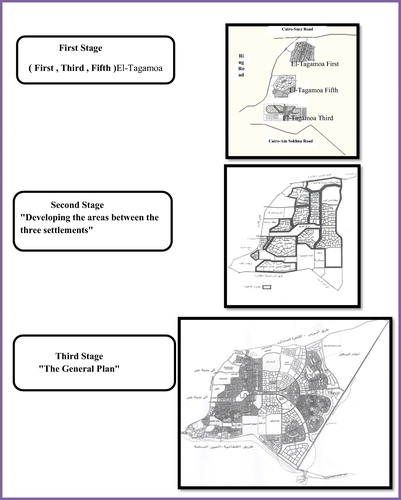
(B) Entrances and circulation system
| • | The city depends essentially on the ring road to the west of Nasr city and is bordered north by the Cairo-Suez desert road and south of Qatamiyia Ain El Sokna road. Three entrances were developed in later stages of laying the plan through, one from Suez desert road and the second and third from the ring road and linking them by rapid axis with Nasr City. | ||||
| • | The internal roads network: The general plan depended on the gradation of the road network, its distribution starting from the arterial road around the city center, then the main roads that separate the different housing areas that link the districts with the center, then the internal roads that link the neighborhood. | ||||
(C) Public utilities
| • | Electricity System was established through four converter stations that provide with necessary electrical power essential for the projects and residential units. | ||||
| • | The water network that follows the water companies of El Obour city, this caused lots of problems and crisis during the past period as a result of the strong pressure and almost threatened the future of the New Cairo city that led the Ministry of Housing to accelerate establishing water rising stations in the city with a promise to finalize it by the end of the year 2014. | ||||
| • | A complete sewage network is currently feeding the city. | ||||
(D) Main sectors
| • | The general plan of the city can be divided into several sectors, according to the growth stages and land uses as follows. | ||||
(E) City center
The city center is considered the artery of the city as it starts from the entrance of the city cutting it as a central axis of services and movements. The area of the center reaches 1100 feddan. It was divided into four sectors that each contains a number of services. All services were developed in the center through the investment companies including the health services without any role of the governmental sector. The center includes many administrative centers of the banks and investment companies. Also, some of the areas of the center were transformed to Luxurious housing compounds.
(F) Industrial zone
The industrial zone reached 1070 feddan in the general plan which included electrical, electronic, chemical industries, food industries and workshops in addition to storage or warehouses and maintenance of car areas, but was not yet authorized till now.
The influence of real estate investment on land uses structure
Real estate investment in New Cairo depended on the residential development that was adopted only in the housing sector, which seems clear in the following:
Increase in the Luxurious Housing Areas
There are no official statistics of distribution of housing types in the city, where it is still “lotus and Kawthar” sectors experiencing changes in the allocation. In addition the changes take place on the eastern sector of the city.
| • | The second phase focused entirely on the city for luxury housing (villas). A total area of 7700 feddan is in “Jasmine, Violets, Daffodils, Northern investors, and South and East of the Academy” districts, while the affordable housing areas reaching 1500 feddan in the Tagamoa third community which developed at the same stage. | ||||
The allocation of large areas of the city to investors for luxury residential compounds
There are about 34 closed luxury housing compounds in the city [Citation14]. Seven of them are greater than 500 feddan, the largest of these gatherings are: Rehab 2220, Barwa 2020, Hyde Park 950, Imaar 904 feddan, in addition of 27 residential communities ranging from 100 to 200 feddan. Bringing the total luxury residential areas closed to the total city area fully is almost 18%.
The control of the major investment companies in most service areas
The laws of supply and demand Dominate, and increase the demand for real estate investment in the city also in the service areas, which resulted in the growth of major character investment services.
Rising real estate prices in general
The residential unit prices and services in the city performed higher rates, compared with other new cities in all housing levels, as a result of the increased demand on the city’s lands, New Cairo city was not included in the most affordable housing programs since the 80s, where there was no allocation of the city’s land for the project “build your home” listed in the Ministry of Housing, New Urban Communities plan in 2006 or the Partnership with the private sector in building the affordable housing units included in the Ministry of Housing and urban Development plan in 2007, or any other later projects since that time and even now. Restricting the allocation of land in the city for the luxurious residential communities closed with the exception of some official lot and unions that provided a limited number of medium housing units but with high prices for other new cities.
General analysis
| 1. | The city passed the stages of development of a large approaching 70%, the urban and social, determinants will reduce the chances of change. | ||||
| 2. | There is a clear lack of general planning of the city and the presence of poor distribution of residential areas and levels of housing. | ||||
| 3. | The development of the city policies is still in over the widening gap between the city identity position and the sustainability of cities by the fundamentals of the most important economic basis that represents a developmental role for the city configuration (see and ). | ||||
Table 1 A comparative study “The theoretical status of developing the new settlements [Citation1], New Cairo city”.
Table 2 Main city sectors, according to growth stages and land uses.
shows a comparison between the theoretical dimensions of the city sustainability and the current status of the New Cairo city, which has been studied by observation, survey and qualitative and quantitative analysis of the development of all sectors of the city.
Table 3 Evaluation of the development of New Cairo city according to sustainability objectives.
According to the previous evaluation, New Cairo city Did not achieve the principles of social, economic and urban sustainability, which leads to future negative impacts. So require some modifications in light of the existing urban determinants.
Recommendations
In light of the above parameters that have been studied in the city, the research is trying to rephrase the urban structure of the city by supporting economic and social development. Therefore recommended, the following:
| (1) | Expansion of investment in the city’s vision of seeing just limited to real estate projects to the social and economic development projects with long-term impact. | ||||
| (2) | Prepare the appropriate changes in the urban plan of the city and restructuring of the nonallocation areas to settle the yield development projects. | ||||
| (3) | Status of New Cairo City on the investment map of Egypt and the selection of suitable developmental projects for the site and population structure in light of the changes in the urban plan, particularly in the eastern sector. | ||||
| (4) | The eastern sector of the city “still under development” through the location of the city and the presence of attraction in the eastern sector to be separated from the city of Cairo and linked by the Suez desert road and Katameya Ain El Sokhna road – that represent the factors forming a good hub for connecting ports and the movement of the main trade outside the Greater Cairo Region. | ||||
| (5) | The restructuring of the housing levels in the eastern sector to be compatible with the resulting new economic base changes. | ||||
| (6) | Documenting indicators and studies based on the real estate sector in the city so as to maintain a balance in land and building prices. | ||||
Conflict of interest
There is no conflict of interest.
Notes
Peer review under responsibility of Housing and Building National Research Center.
References
- Town Planning and Heritage: Principles Government, Town Planning Legislation, Heritage, Sustainability and Environmental Law, June 2014.
- Gaffaney, Andrea, New Urbanism Principles and Practices, Sustainable Aspects Applicability to China, 2010.
- Ameen, Aly, Urban Growth mechanisms in New Cities, Cairo University – Faculty of Engineering, 2000.
- Adeep, sameh, Housing Economics Under Market Mechanisms, Cairo University – Faculty of Engineering, 2000.
- Real Estate, Oxford English Dictionary Online (Retrieved 18.09.11).
- Real Estate Regulation, Commonwealth of Virginia Real Estate Board, Title 54.1, 2008 (Chapter 21).
- Hiroaki Suzuki et al., Eco2 Cities, Ecological Cities as Economic Cities, The Australian Government, AusAID, the World Bank, 2009.
- Saudi Arabia’s Economic Cities, Saudi Arabia General Investment Authority, <http://www.oecd.org/mena/investment/38906206.pdf (access December 2014).
- Investment Opportunities at Masdar City, 2012, <http://www.%20Masdar.ae (access December 2014).
- http://https://www.Masdar.%20Com (access December 2014).
- http://https://www.abudhabi.ae (access December 2014).
- The Official Website of New Urban Communities Authority, <http://www.newcities.gov.eg (access December 2014).
- The Official Publication of the New Cairo city, New Urban Communities Authority (NUCA), 2010.
- Yousry, Ahmed, The Privatization of Urban Development in Cairo, Lessons Learned from the Development Experience of Al Rehab Gated Community, Faculty of Urban and Regional Planning, Cairo University, 2010.

